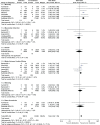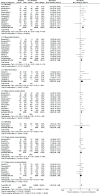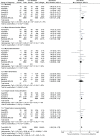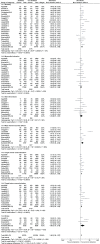In-hospital, short-term and long-term adverse clinical outcomes observed in patients with type 2 diabetes mellitus vs non-diabetes mellitus following percutaneous coronary intervention: A meta-analysis including 139,774 patients
- PMID: 30813214
- PMCID: PMC6408074
- DOI: 10.1097/MD.0000000000014669
In-hospital, short-term and long-term adverse clinical outcomes observed in patients with type 2 diabetes mellitus vs non-diabetes mellitus following percutaneous coronary intervention: A meta-analysis including 139,774 patients
Abstract
Background: Several studies have shown that patients with type 2 diabetes mellitus (T2DM) have worse clinical outcomes in comparison to patients without diabetes mellitus (DM) following Percutaneous Coronary Intervention (PCI). However, the adverse clinical outcomes were not similarly reported in all the studies. Therefore, in order to standardize this issue, a meta-analysis including 139,774 patients was carried out to compare the in-hospital, short-term (<1 year) and long-term (≥1 year) adverse clinical outcomes in patients with and without T2DM following PCI.
Methods: Electronic databases including MEDLINE, EMBASE, and the Cochrane Library were searched for Randomized Controlled Trials (RCTs) and observational studies. The adverse clinical outcomes which were analyzed included mortality, myocardial infarction (MI), major adverse cardiac events (MACEs), stroke, bleeding, target vessel revascularization (TVR), target lesion revascularization (TLR), and stent thrombosis. Risk Ratios (RR) with 95% confidence intervals (CI) were used to express the pooled effect on discontinuous variables and the analysis was carried out by RevMan 5.3 software.
Results: A total number of 139,774 participants were assessed. Results of this analysis showed that in-hospital mortality and MACEs were significantly higher in patients with T2DM (RR 2.57; 95% CI: 1.95-3.38; P = .00001) and (RR: 1.38; 95% CI: 1.10-1.73; P = .005) respectively. In addition, majority of the short and long-term adverse clinical outcomes were also significantly higher in the DM group as compared to the non-DM group. Stent thrombosis was significantly higher in the DM compared to the non-DM group during the short term follow-up period (RR 1.59; 95% CI: 1.16-2.18;P = .004). However, long-term stent thrombosis was similarly manifested.
Conclusion: According to this meta-analysis including a total number of 139,774 patients, following PCI, those patients with T2DM suffered more in-hospital, short as well as long-term adverse outcomes as reported by most of the Randomized Controlled Trials and Observational studies, compared to those patients without diabetes mellitus.
Conflict of interest statement
The authors have no funding and conflicts of interest to disclose.
Figures





Similar articles
-
Comparing the adverse clinical outcomes in patients with non-insulin treated type 2 diabetes mellitus and patients without type 2 diabetes mellitus following percutaneous coronary intervention: a systematic review and meta-analysis.BMC Cardiovasc Disord. 2016 Nov 25;16(1):238. doi: 10.1186/s12872-016-0422-0. BMC Cardiovasc Disord. 2016. PMID: 27887590 Free PMC article.
-
Short- and long-term cardiovascular outcomes in insulin-treated versus non-insulin-treated diabetes mellitus patients after percutaneous coronary intervention: A systematic review and meta-analysis.Indian Heart J. 2022 Jan-Feb;74(1):13-21. doi: 10.1016/j.ihj.2021.12.004. Epub 2021 Dec 11. Indian Heart J. 2022. PMID: 34906538 Free PMC article.
-
Long-term cardiovascular outcomes of biodegradable polymer drug eluting stents in patients with diabetes versus non-diabetes mellitus: a meta-analysis.Cardiovasc Diabetol. 2023 Aug 29;22(1):228. doi: 10.1186/s12933-023-01962-w. Cardiovasc Diabetol. 2023. PMID: 37644465 Free PMC article. Review.
-
Are women with type 2 diabetes mellitus more susceptible to cardiovascular complications following coronary angioplasty?: a meta-analysis.BMC Cardiovasc Disord. 2017 Jul 27;17(1):207. doi: 10.1186/s12872-017-0645-8. BMC Cardiovasc Disord. 2017. PMID: 28750607 Free PMC article. Review.
-
Short-Term Versus Long-Term Adverse Cardiovascular Outcomes Post Percutaneous Coronary Intervention in Patients with Insulin-Treated Type 2 Diabetes Mellitus: A Simple Meta-Analysis.Diabetes Ther. 2019 Aug;10(4):1487-1497. doi: 10.1007/s13300-019-0656-9. Epub 2019 Jun 29. Diabetes Ther. 2019. PMID: 31256352 Free PMC article.
Cited by
-
Impact of Chronic Kidney Disease on Outcomes of Percutaneous Coronary Intervention in Patients With Diabetes Mellitus: A Systematic Review and Meta-Analysis.Tex Heart Inst J. 2023 Jan 1;50(1):e227873. doi: 10.14503/THIJ-22-7873. Tex Heart Inst J. 2023. PMID: 36753753 Free PMC article.
-
Receptor for Advanced Glycation End Products (RAGE) and Mechanisms and Therapeutic Opportunities in Diabetes and Cardiovascular Disease: Insights From Human Subjects and Animal Models.Front Cardiovasc Med. 2020 Mar 10;7:37. doi: 10.3389/fcvm.2020.00037. eCollection 2020. Front Cardiovasc Med. 2020. PMID: 32211423 Free PMC article. Review.
-
Prediabetes predicts adverse cardiovascular outcomes after percutaneous coronary intervention: a meta-analysis.Biosci Rep. 2020 Jan 31;40(1):BSR20193130. doi: 10.1042/BSR20193130. Biosci Rep. 2020. PMID: 31793983 Free PMC article.
-
Case Fatality of Patients With Type 1 Diabetes After Myocardial Infarction.Diabetes Care. 2022 Jul 7;45(7):1657-1665. doi: 10.2337/dc22-0042. Diabetes Care. 2022. PMID: 35679070 Free PMC article.
-
Ticagrelor monotherapy after a short course of dual antiplatelet therapy with ticagrelor plus aspirin following percutaneous coronary intervention in patients with versus without diabetes mellitus: a meta-analysis of randomized trials.BMC Cardiovasc Disord. 2024 Mar 19;24(1):166. doi: 10.1186/s12872-024-03836-9. BMC Cardiovasc Disord. 2024. PMID: 38504170 Free PMC article.
References
-
- Wild S, Roglic G, Green A, et al. Global prevalence of diabetes: estimates for the year 2000 and projections for 2030. Diabetes Care 2004;27:1047–53. - PubMed
-
- Ruderman N, Williamson J, Brownlee M. Hyperglycemia, Diabetes, and Vascular Disease. 1992;New York: Oxford University Press, 21–29.
-
- Javaid A, Steinberg DH, Buch AN, et al. Outcomes of coronary artery bypass grafting versus percutaneous coronary intervention with drug eluting stents for patients with multivessel coronary artery disease. Circulation 2007;116:I200–6. - PubMed
-
- Lee TT, Feinberg L, Baim DS, et al. Effect of diabetes mellitus on five-year clinical outcomes after singlevessel coronary stenting (a pooled analysisof coronary stent clinical trials). Am J Cardiol 2006;98:718–21. - PubMed
Publication types
MeSH terms
LinkOut - more resources
Full Text Sources
Medical
Miscellaneous

